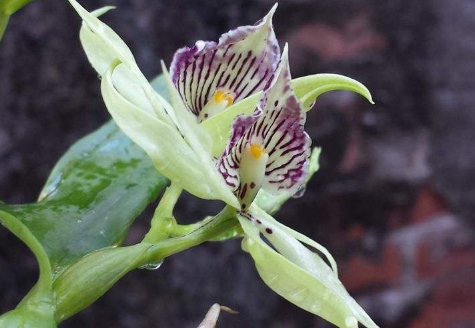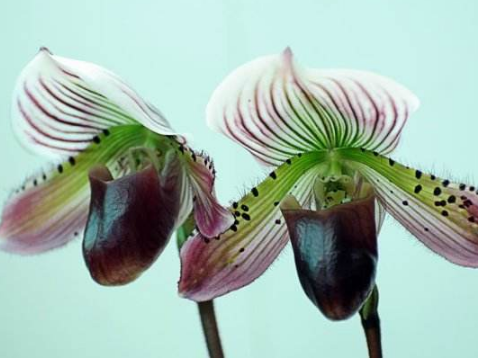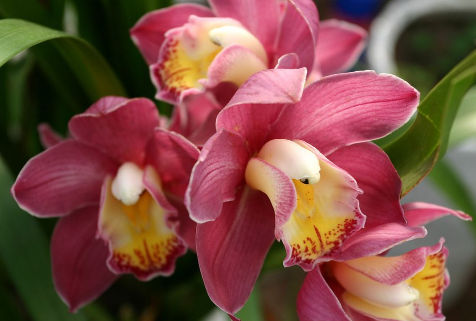Culture method of octopus orchid
1. Soil
Octopus orchid soil requirements are not high, to use loose and breathable fertile soil, generally choose fine-grained volcanic rock, bark or burning soil, you can also buy special cultivation soil.

two。 Temperature
Octopus orchids mostly grow in forests at an altitude of 2000m, with strong temperature adaptability, suitable temperature of 15-35 ℃, high temperature in summer to avoid burns, no less than 8 ℃ in winter, and pay attention to keep warm.
3. Light
Octopus orchids like light, lack of light will lead to plant growth slender, affecting flowering, summer should pay attention to shade, other seasons can receive more light.
4. Watering
Octopus orchid needs a lot of water during the growing period, which is usually watered every 3 days. In summer, it is necessary to sprinkle water on the leaves, not only to ensure moist air, but also to cool the plants, and to reduce watering in winter.
Culture methods and matters needing attention of Octopus Orchid
The Latin name Prosthechea cochleata (L.) W.E. Higgins
Also known as scallops.
The plant kingdom.
Phylum angiosperm
Monocotyledon class
Subclass lily subclass
Kolanco
Octopus orchid
The distribution area is native to Central America, the West Indies, Colombia, Venezuela and Florida.
Octopus orchid, wing petals and sepals are linear, yellowish green, slightly twisted and drooping naturally, shaped like the small octopus of the Sea Thief King of the Sea, hence the name. It is also called scallop orchid because its lips look like beautiful scallop shells.
1. Classification information
Latin name: Prosthechea cochleata (L.) W.E. Higgins
Classification: Orchidaceae octopus orchid
2. Basic form
Their wings and sepals are linear, yellowish green, slightly twisted and drooping naturally, shaped like the small octopus of the Sea Thief King of the Sea, hence the name. They are also called scallop orchid because their lips look like beautiful scallop shells. Its flower posture is unique, it is a kind of epiphytic orchid with high ornamental value; the pseudo-bulb is flat-oval, the raceme is drawn from the pseudobulb, and the lip is purple-black with yellow stripes, which is located on the upper part of the flower and reverses to form a scallop-shaped style; the flower blooms one after another, and the flowering period is as long as 4-5 months.
3. Place of origin
Octopus orchid is native to Central America, West Indies, Colombia, Venezuela and Florida. Because of its unique flower posture and long flowering period, Octopus Orchid has been cultivated in horticulture and has attracted much attention.
Family Culture methods of Octopus Orchid
Soil requirement
Octopus orchids originally grew in alpine and cold areas, and the requirements for soil are not particularly high. But generally speaking, the drainage and air permeability are better. Generally choose fine-grained volcanic rock, bark or burning soil, of course, you can also buy it directly from the florist.
Temperature range
Octopus orchid grows in the forest at an altitude of 2000m and has strong adaptability to temperature. The temperature is 15-35 ℃ and grows well. It is hot in summer, avoid overheating at noon and cool down with humidity. The winter temperature should not be lower than 8 ℃. If the temperature is low, the light should be increased properly and the roots should be watered less to ensure the relative dryness of the roots.
How to apply fertilizer
Octopus orchid plant is larger, its own fertilizer demand is larger, especially in the vigorous growth period. Apply fertilizer once every two weeks for daily maintenance, increase the number of fertilization and increase the amount of fertilizer during the growing period. Liquid compound fertilizer is used as fertilizer. Try not to use granular fertilizer, which is not easy to be absorbed by the plant.
Plenty of light.
Octopus orchids like bright sunlight, but not direct sunlight. Insufficient light will lead to weak plant growth and poor flowering. There is plenty of sunshine in summer, so it should be moderately shaded, especially at noon. The north does not need shade in winter and can receive sunlight all day long.
Watering the right amount
Octopus orchid growth needs more water, generally every 3 to 5 days to water, appropriate extension of time in winter, during the period to often spray water to the leaves to ensure air humidity. Watering and fertilizing at the same time should cooperate with each other, usually fertilizing 1-2 should be watered once.
- Prev

Culture methods of Paphiopedilum
1. Soil pot cultivation of Paphiopedilum can be arranged with rotten leaf soil, peat and so on. When you put on the basin, you can pad a layer of broken brick particles in the basin to maintain good air permeability and be conducive to the growth of plant roots. two。 Temperature Paphiopedilum likes a warm environment, and the suitable temperature is different for different varieties.
- Next

Matters needing attention in the Culture of Cymbidium
1. Cymbidium is originally a plant growing in mountainous areas at high altitude. it requires high ventilation conditions and should be protected in a cool place. two。 Cymbidium can not be watered too often, the soil can be properly dry, watering flowers and leaves must be a small amount, or let the water be dried quickly, too much water flowing into the center of the leaves will affect plant growth.
Related
- Fuxing push coffee new agricultural production and marketing class: lack of small-scale processing plants
- Jujube rice field leisure farm deep ploughing Yilan for five years to create a space for organic food and play
- Nongyu Farm-A trial of organic papaya for brave women with advanced technology
- Four points for attention in the prevention and control of diseases and insect pests of edible fungi
- How to add nutrient solution to Edible Fungi
- Is there any good way to control edible fungus mites?
- Open Inoculation Technology of Edible Fungi
- Is there any clever way to use fertilizer for edible fungus in winter?
- What agents are used to kill the pathogens of edible fungi in the mushroom shed?
- Rapid drying of Edible Fungi

